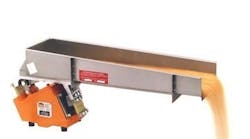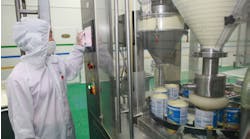Vibratory equipment play a critical role at many plants. They handle many types of screening: size separating, scalping or removing oversized product and conglomerates, and dedusting or fines removal (Figure 1). Vibratory feeders and conveyors frequently serve to transport raw materials and finished product from one operation to another or from one area of a plant to another (Figures 2 and 3) — while, in many cases, also allowing for secondary operations such as screening, cooling, drying and contaminant detection.
Figure 1. Units like this can process dry materials or be used with slurries or for dewatering.
Figure 2. Such units suit applications requiring fast material travel but also quick stopping.
Figure 3. This low-horsepower, low-profile unit commonly handles bulk materials.
The types and quality of vibratory feeding, conveying and screening equipment, as well as the processes to which they are applied, are continually evolving. So, it’s essential to stay current on the latest developments and review your equipment often. That way, you may be able to identify opportunities to update your processing line — and, with it, to improve profitability and gain a much-needed competitive edge.
If an upgrade seems promising, you should consider several crucial factors in your assessment.
Keep requirements reasonable
The most significant point to remember is to set and maintain realistic requirements. It is essential to be as specific as possible when identifying your needs. Get inputs from everyone on staff who will be a part of the decision-making process.
Don’t ignore or forget the most basic of questions. How long do you plan to operate this line? What are your present capacity requirements and how will they change in the future? Then, ask some more-in-depth questions. Will the equipment need to perform multiple functions (such as conveying and screening, conveying and spreading, or metering and measuring)? Will the equipment handle multiple products and, if so, what types? Does the operating environment pose particular issues (e.g., washdown, hazardous electrical classification or high temperatures)? Are there site-specific power requirements? What installation envelope is available for this equipment? Does the process require special handling for the product? What are the product’s physical characteristics — particle size, bulk density, flowability, fluidizability, etc. — and is it friable or hygroscopic?
By understating requirements, you will wind up with equipment that won’t fulfill all of your needs and may cost more in the long run because of reduced efficiency and the need for supplementary equipment purchases. But overstating requirements will lead to buying unneeded features, resulting in excessive equipment costs.
Safety is key but, again, you don’t want to exaggerate requirements. Consider safety requirements particular to your plant or your industry. Also think about any special electrical, mechanical or air requirements you may have. If your plant has a safety committee, get them involved in the process of choosing the equipment.
Carefully assess sanitary requirements. While your plant or industry may call for sanitary construction, keep in mind that the word “sanitary” can be vague and often means different things to different people. Be specific about the surface finish for the product and non-product contact areas.
Continuous weld fabrication and radius corners may be critical for the product areas but not necessarily required elsewhere. If you have a written sanitary specification, show it to your equipment vendors so there is no misinterpretation. Sanitary construction is time consuming, so any added features will greatly impact your cost.
Reviewing immediate and possible future goals of the equipment purchase will help to determine what equipment features are required. Is the goal to automate the process or is operator assistance still required? Will the addition of a particular feature result in a process cost reduction? Will a specific feature reduce maintenance costs? Will certain equipment features make it easier to implement enhancements to the process later? Do electrical classification requirements necessitate a particular feature? Does government regulation of the process demand a specific feature? Does the budget provide flexibility to cost-justify additional features? Answer all of these questions thoroughly before you decide which features are necessary.
Factor in operations
Next, consider reliability and user friendliness. The goal should be to select equipment that employees can operate and maintain with little or no assistance.
Cleaning is vital for keeping equipment running smoothly. So, ideally, operators should be able to disassemble the components for routine cleaning. Find out exactly what preventive maintenance entails and its frequency. Equipment requiring complicated maintenance or, in the worst case, constant repair reduce employee productivity. State-of-the-art does not mean experimental.
Search for options that make your equipment easy to operate and question the need for those that complicate operation. For example, if you need a screening section in a tray, consider quick-release or even magnetic hold-downs that require no tools. Check whether covers will be easy to open or remove and whether these tasks will require a mechanic.
Equipment simplicity often can bolster the prospects for success. Fewer moving parts generally mean less chance of a breakdown or problem. In cases where your processing line must operate continually, reliability is the most important feature to look for.
Assess the difference in likely downtime between options. For instance, electromagnetic drives don’t have belts or bearings that require maintenance. Verify that the moving parts on the equipment’s mechanical units are readily available— otherwise, you may have to go back to the manufacturer for spare parts. It is wise to ask for a spare parts list at the time of purchase, as well as a recommendation of what to keep on hand.
Can your employees repair the equipment on-site? Does some servicing require a factory technician or, even more burdensome, return to the manufacturer? Find out what the process for returning equipment for repair or modification entails. Additionally, determine the typical lead-time for turnaround.
As with most equipment, the lowest purchase price is not always the best buy long-term. Consider ongoing operating and maintenance costs and the availability of repair and replacement parts.
Mull multifunctionality
Using equipment for two or more functions often can save both space and money. So, determine what functions this particular point in the process requires. Will utilizing multifunction equipment produce a process cost reduction or eliminate a high-maintenance piece of equipment? Also, assess whether a multifunction unit can perform a function that protects downstream equipment. In some cases, multifunction units can even help you better meet quality control requirements. But, before deciding on multifunction equipment, verify that enough space is available.
For scalping conglomerates or dedusting products, consider a vibratory conveyor or feeder. The conveyors can even handle dewatering, cooling or drying your product. They also can be integrated into systems for detecting and removing foreign matter. For instance, by suspending magnets over a stainless tray or putting them in a chute at the end of a tray conveyor, you can capture ferrous contaminants. Some processors are even using vibrating conveyors with nonmetallic trays that can feed bulk product through metal detectors to pick up non-ferrous contaminants.
Consider the environment
Your new equipment should be kind to the environment both inside and outside your plant. So, take into account factors such as noise levels. Quieter units often help operators perform more effectively. Vibratory feeders and conveyors can operate at relatively low noise levels; sound pressure readings should not exceed 70 to 80 decibel on a weighted scale (db [A]) for the equipment itself.
In addition, equipment that reduces the transmission of vibrations can protect buildings from structural damage and create a better work environment for employees. Single-mass conveyors, while least expensive, don’t cancel vibration caused by tray movement. Two-mass or natural-frequency vibrators usually have at least 90% of their vibration cancelled by isolators or counter weights.
Attempt to keep power consumption to a minimum, as well. Electromagnetic feeders and conveyors can differ greatly in power requirements, with some units using up to 65% less power than other equal-sized equipment. For motor-driven units, be sure to compare their horsepower. Remember that you will pay for equipment one time, but you pay the utility bill every month.
Consider reducing the use of compressed air or fluids that could contaminate product. Compressed air is expensive to manufacture and keep clean and dry (see article on p. TK). Unless you have sources of “free” air, favor electric motors over air or hydraulic motors.
Engineer the project right
If engineering will be done in-house, I recommend that you use a “quality circle.” This group, drawn from various areas to improve product or operational quality, usually does the best job in determining requirements and expectations, as well as identifying any pitfalls.
Work with your “quality circle” to answer some important questions. Does the equipment satisfy the required electrical classification for the operating environment? Does it meet the specific construction and surface-finish requirements? Is this a clean-in-place process and, if so, is the unit suitable for such cleaning? Is special equipment, such as a crane or hoist, required for installation and do the engineering specifications spell this out?
If a subcontractor will perform the engineering, check that the firm has had experience with your type of product and the equipment you want to use. Find out who will be responsible for installing the equipment and whether or not vendor technical support will be required. Also inquire about possible charges for vendor technical support.
Remember that hopper designs can either enhance or reduce product discharge onto a conveyor or feeder. An improperly designed hopper can create poor conveying and screening efficiency. Therefore, investigate proper designs.
Be cautious of consultants who use boilerplate. They sometimes employ standardized specifications to reduce costs but the resulting solution may not provide the best results.
Finally, when developing specifications, prepare them, whenever possible, general enough to solicit several qualified bidders.
Select carefully
Compare all equipment you are considering by developing a comprehensive list of the features, benefits and costs of each. Give suppliers as much information as possible so they can make the most-informed suggestions. Remember that you can’t expect something for nothing. Don’t scrimp on quality to save money today. Quality equipment pays you back on an on-going basis through improved productivity and efficiency. Lastly, whenever possible, work with suppliers and people you know and trust.
Linda Mioduszewski is a technical sales representative for Eriez Magnetics, Erie, Pa. E-mail her at [email protected].


